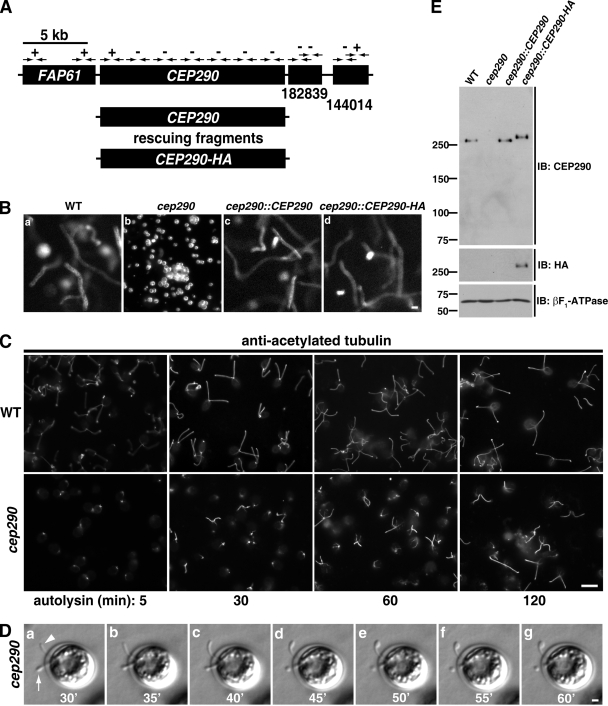Figure 1.
Identification of a C. reinhardtii CEP290 mutant. (A) Schematic of the region of C. reinhardtii chromosome 3 containing the CEP290 (POC3) locus. CEP290 is flanked by the FAP61 gene and by gene models encoding predicted proteins nos.182839 and 144014 in Joint Genome Institute version 4.0 of the Chlamydomonas genome (http://genome.jgi-psf.org/Chlre4/Chlre4.home.html). Arrows indicate the positions of PCR primer pairs; plus and minus symbols indicate whether a PCR product was generated using genomic DNA of strain Y168 as template (all primer pairs amplified a product when wild-type genomic DNA was used as template). Rescuing constructs consisted of either untagged or HA-tagged genomic DNA fragments containing only the CEP290 gene. (B) 30-frame image averages of videos (acquired at 30 frames per second) depicting the mutant phenotype (cep290) and rescue of the phenotype (cep290::CEP290 and cep290::CEP290-HA). Motile cells are seen as long meandering tracks, whereas nonmotile (palmelloid) cells appear as bright foci (cep290). See Videos 1–4. Bar, 10 µm. (C) Palmelloid cep290 mutant cells were released from the mother cell wall by treatment with autolysin, then fixed at the indicated time points after the addition of autolysin and processed for immunofluorescence using antibodies to acetylated tubulin. The mutant cells have stumpy flagella that partially elongate over time. Bar, 10 µm. (D) cep290 mutant cells were hatched with autolysin, immobilized in 0.5% agar, and imaged at the indicated time points (minutes) after the addition of autolysin. The arrowhead marks a flagellum that began to elongate then formed a bulge. The arrow marks a flagellum that failed to elongate and formed a bulge. Bar, 1 µm. (E) Western blot of whole cells. A peptide antibody generated against the C-terminal 14 amino acids of C. reinhardtii CEP290 is specific and confirms the absence of CEP290 in the mutant strain and expression of CEP290 in the rescued strains. βF1-ATPase is a mitochondrial protein used as a loading control. The positions of standard proteins and their molecular masses in kD are indicated.

